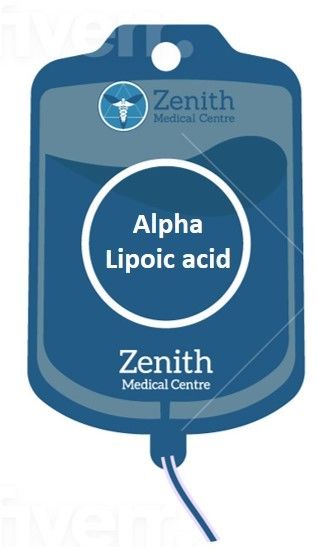Infusion Therapy & Shots
Alpha Lipoic acid
| Alpha-lipoic acid (ALA) is an antioxidant normally made by the body. It is found in the mitochondria of every cell, where it helps to generate energy. The role of antioxidants is to attack "free radicals," which are generated in the process of energy production. Free radicals cause harmful chemical reactions that can damage cells, making it harder for the body to fight off infections. Free radicals also damage cells and by extension our tissues. Unlike other antioxidant which works only in water (e.g. Vitamin C) alpha-lipoic acid works both in fat and water soluble part of our tissues. That means it can work throughout the body. Antioxidants in the body are used up as they attack free radicals. But evidence suggests alpha-lipoic acid may help regenerate these other antioxidants and make them active again. Alpha-lipoic acid is also sometimes called lipoic acid for short. ALA is found to be very helpful in diabetics, dementia, cancer support and a host of other neurodegenerative diseases. It is available in oral forms, injectable and in infusion. |  |
Functions of ALA
Alpha lipoic acid (ALA) carries out highly beneficial functions in the human body:
- ALA is responsible for protecting our energy reserves.
- It helps boost immunity.
- It supports the body's functions.
- It keeps body weight in check and it is used to assist weight loss.
Many popular anti-ageing injections focus on specific areas of the body only, whereas the ALA IV is into the bloodstream intravenously, which benefits skin across the entire body.
It’s Role as Cancer Treatment Adjunct
Preparation of the IV ALA is important as alpha lipoic acid is destroyed by light so it is delivered with protection of the IV bag from light exposure. The most severe reaction patients experienced is a feeling of nausea following the treatment. This clear in a short time after the therapy. In fact, IV ALA is often used to reduce the side effects of other cancer treatments.
Neurotoxicity: Although chemotherapy is a life-saving form of treatment, a common side effect is neurotoxicity leading to peripheral neuropathy. A neuropathy gives rise to a set of symptoms from damage to the nerves controlling how our arms and legs feel and move. Typically, peripheral neuropathies stop once chemotherapy treatment has finished and neurotoxicity is reduced, but the symptoms may also last for years. However, IV ALA can be used to reduce the neuropathic pain as a side effect of chemotherapy drugs (Gedlicka et al. 2002 & Melli et al. 2008).
Diarrhoea: is another common side effect of chemotherapy – in fact, up to 50-80% of treated patients will experience this symptom because of therapy. Chemotherapy drugs like methotrexate often induce intestinal toxicity due to oxidative stress and DNA damage leading to intestinal cell toxicity. As such, using ALA prior to chemotherapy helps protect against intestinal toxicity and improve the consistency of stool.
Cardiac Toxicity: A lesser known side effect of chemotherapy drugs is cardiac toxicity. Cardiotoxicity is typically rare, yet may occur in more than 20% of patients treated with doxorubicin, daunorubicin or fluorouracil (Pai VB, Nahata MC, 2000). They described the following cardiac events that may occur as a result of such chemotherapy drugs: mild blood pressure changes, thrombosis, electrocardiographic changes, arrhythmias, myocarditis, pericarditis, myocardial infarction, cardiomyopathy, cardiac failure (left ventricular failure) and congestive heart failure. ALA does not only ameliorates these symptoms but is also protective against the onset of cardiotoxicity.
Generally this infusion is not given alone but as part of a comprehensive plan after clinical assessment. Speak to us today to see what option there are to support you in your journey to recover your health.
Reference
- Salehi B, Berkay Yılmaz Y, Antika G, et al. Insights on the Use of α-Lipoic Acid for Therapeutic Purposes. Biomolecules. 2019;9(8):356. Published 2019 Aug 9. doi:10.3390/biom9080356
- Carbonelli MG, Di Renzo L, Bigioni M, Di Daniele N, De Lorenzo A, Fusco MA. Alpha-lipoic acid supplementation: a tool for obesity therapy? Curr Pharm Des. 2010;16 (7):840-6. doi: 10.2174/138161210790883589. PMID: 20388095.
- Wollin SD, Jones PJ. Alpha-lipoic acid and cardiovascular disease. J Nutr. 2003 Nov;133 (11):3327-30. doi: 10.1093/jn/133.11.3327. PMID: 14608040.
- Park, Sungmi & Karunakaran, Udayakumar & Jeoung, Nam Ho & Jeon, Jae-Han & Lee, In-kyu. (2014). Physiological Effect and Therapeutic Application of Alpha Lipoic Acid. Curr Med Chem. 21. 10.2174/0929867321666140706141806.
- Gedlicka C, Scheithauer W, Schüll B, Kornek GV. Effective treatment of oxaliplatin-induced cumulative polyneuropathy with alpha-lipoic acid. J Clin Oncol. 2002 Aug 1;20 (15):3359-61. doi: 10.1200/JCO.2002.99.502. PMID: 12149316
- Melli G, Taiana M, Camozzi F, Triolo D, Podini P, Quattrini A, Taroni F, Lauria G. Alpha-lipoic acid prevents mitochondrial damage and neurotoxicity in experimental chemotherapy neuropathy. Exp Neurol. 2008 Dec;214 (2):276-84. doi: 10.1016/j.expneurol.2008.08.013. Epub 2008 Sep 9. PMID: 18809400.
- Pai VB, Nahata MC. Cardiotoxicity of chemotherapeutic agents: incidence, treatment and prevention. Drug Saf. 2000 Apr;22 (4):263-302. doi: 10.2165/00002018-200022040-00002. PMID: 10789823.
